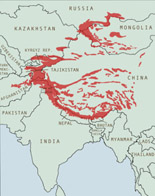
Camera trap. Photo Snow Leopard Conservancy
Thanks to camera trapping techniques we’re getting more and more photos of snow leopards in the wild. Camera trapping is pretty expensive and time consuming. Expensive not because of the gear which is often a pretty standard camera but because of the effort it takes to make it happen. Firstly you’ve got to get a team into areas that are always remote cos that’s just were our dear furry friends hang out. Then you have to live there for a period of time because they don’t always come out on the first invitation. Sometimes like Steve Winter (see his award winning pic) it takes at least a few months of patience in harsh weather and altitude conditions. The current project the Snow Leopard Trust is running in Mongolia has researchers staying many months over a period of years!
The technique is used in a small area where you know there are at least a few snow leopards passing through because you’ve seen scats (droppings) or scrapings. The camera is set up on paths and trails and the picture is taken when the camera is triggered by the passing animal. The trigger goes off as the sensor senses body heat. Things can go wrong of course, like the batteries running out, the animal being too quick to be well photographed, the camera getting damaged etc. But as we can see from the many photos now being released the technology is really helping researchers learn more about snow leopard numbers and habitat.
If there are a couple of snow leopards in one area and the camera catches them then because each animal has unique markings in its rosettes you can distinguish between different individuals, although it’s usually hard to tell if they’re male or female.




{ 0 comments… add one }